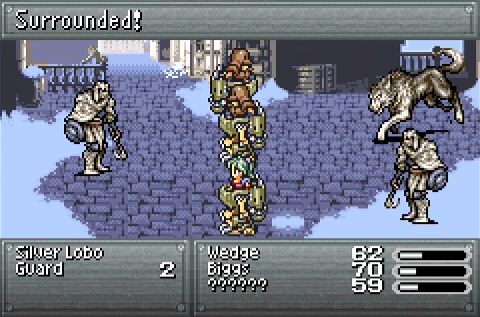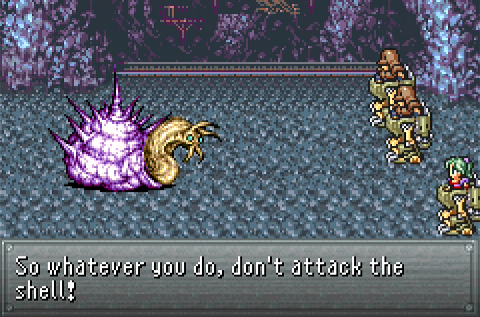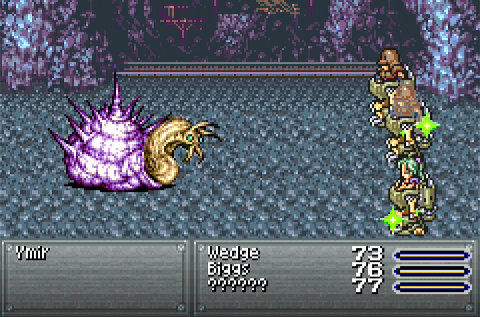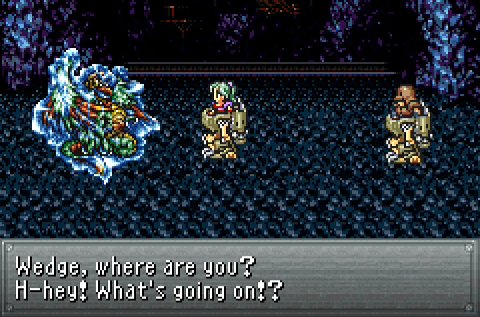For newcomers to the role-playing genre, Final Fantasy VI‘s opening could be fairly disorienting, I imagine. Your little robot guys start walking, then some tiny people run up to you. The screen freaks out as a crunchy sound effect plays and all of a sudden you’re in a different place with intense music playing and barely animated sprites wobbling while numbers fly up. Square kindly made the fight through Narshe a gentle affair, with few threats and a sense of progression as you make your march up the screen. All battles here are scripted, and they’re not random: Each battle is initiated by a small character sprite that makes contact with your party leader. First, you fight one dog, then two soldiers, then two dogs, then two more soldiers. You can paste these guys in no time.
However, on your fifth fight, you start to see a little more of the combat system’s nuance when a pincer attack begins.
Your party shifts from its usual spot on the right side of the screen to the center, while enemy sprites surround your characters on either side. If you’ve gotten into the habit of using ??????’s Bio Blast attack, which hits multiple targets, you’ll discover that you’re now only able to target one column of enemies or the other; you can’t multi-target both groups of enemies. Which makes sense. You’d hit your own party there in the middle.
This also confers a few other disadvantages onto you. Enemies get initiative when they pincer your party, meaning their ATB gauges are full at the battle’s outset, giving them the ability to make the first strike. The party’s ATB meters, which usually start out full (or nearly so), begin nearly empty in this fight. Also, the idea of rows — which admittedly you haven’t explored as of yet in FFVI — go out the window in the event of a pincer ambush. Normally, characters in the back row stand further away from the enemy and are less likely to become targets of attacks, and suffer less damage from most physical attacks. When you’re surrounded, the squishy back-row types become every bit as exposed to danger as the front-row warriors. Obviously, this is not an ideal combat scenario.
Still, the challenge posed Narshe’s sad little provincial soldiers is so negligible as to be a non-factor, and you’ll easily stomp through even the pincer ambush. The fight through town is fairly brief, especially with the threat level here at about nil, and there’s no way to move but forward. With the introductory battles out of the way, your team reaches the caves and the game proper begins.
While you still can’t deviate from the path inside the caves — the branching route denoted by the mine cart tracks to the right runs through an aperture that once again you Magitek armor proves too bulky to clear — the battles are no longer scripted here. Instead, the game shifts over to random battles. Rather than presenting you with enemy sprites to initiate fights, FFVI simply makes them happen when- and wherever. Every step you take brings with it the probability that it will cause your party to enter battle. Foes are “invisible” compared to the soldiers in the town, though there are still a few scripted encounters in the caves.
The one branch you can explore here appears almost immediately to your left, where an obtrusive glowing spot on the floor of an alcove begs your attention. This is a save point, an opportunity to record your progress in the midst of a combat scenario. The game offers to explain this mechanic here, though there’s very little chance you’ll need to reload your progress here in the caves. The important thing to know is that normally you can only save your data while on the world map. Save points offer the exception to that rule, giving you a chance to record in the midst of exploration. These appear fairly infrequently, but they’re not too hard to miss given the way they shine and pulse in the darkness.
The caves introduce a new kind of enemy, Wererats. I don’t know if these are men who turn into rats or rats who turn into wolves or what, but in any case they aren’t any more threatening than the guards you’ve already pasted. However, they do have an interested attribute that you may or may not notice, depending on your tactics: They absorb poison. If you’ve been leaning on the crowd-control capabilities of the Bio Blast weapon, this can come as quite a surprise. Rather than vanished abruptly upon being Bio Blasted, the Wererats instead take what would normally be the damage value of the beam and convert it into life-giving healing power.
Elemental absorption will become a more important factor later in the game, and there’s no mention of these creatures’ capability. I suspect they were given their poison-absorption attribute as a way to clue players who decided to spam every encounter with the Bio Blast into the fact that you can’t simply steamroll the game with a single action. (Well, not in theory, anyway.) The one group attack your prologue party possesses is completely useless here. Worse than useless, actually; it helps the enemy. So you need to mix things up, see.
After a hopeless last-ditch effort by the Narshe watch to halt your advance, they roll out their heavy hitter. It’s… a giant snail. Ymir, the whelk, maintains a Final Fantasy tradition: It has a defensive cycle that the game makes a big deal of, then rarely uses again. In this case, Ymir offers two targets, its head and its shell. So, again, you can’t use the Bio Blast, because it will hit both targets, and if the shell takes damage, Ymir does this:
…striking one or all the party members with a powerful retaliatory lightning strike that hits for about half the target’s max HP. It’s by far the most deadly attack in this portion of the game, though as the in-combat dialogue warns you, it only happens if you strike the shell.
However, like the Mist Dragon in Final Fantasy IV, Ymir has a tendency to switch to a combat form that leaves you with only the “bad” target. When it withdraws its head, you can’t attack without taking far more relative damage than you deal. You’re given a brief warning that it’s about to transform (the snail grumbles some wordless dialogue first), and once that happens all you can really do is wait. Or, if you get sloppy and attack after the shell has retreated, you can use this lull to heal up.
In other words, the point here is that you can’t simply press the attack at all times. Some enemies, especially bosses, have more complex battle patterns that require some manner of tactics and patience to overcome. This is made something of a lie by the fact that FFVI’s mechanics are so easy to abuse as to render the whole idea of difficulty or tactics moot, but their heart’s in the right place.
Something else worth noting is that ?????? doesn’t simply have more Magitek commands than her Imperial companions; she has more battle commands, period. If you choose Magic from the combat menu, you can either cast Fire or Cure. These are made almost entirely moot by the Magitek armor, though if you care to experiment you’ll find spells have a level of versatility lacking in the machine-powered abilities: You can switch targeting fields with spells (turning offensive ability against allies or healing foes), and Cure can be multi-targeted if you know the trick.
This may not seem like a big deal now, and it definitely has no value against Ymir, but those Wererats offer a handy test bed for this power. As you might suspect from their affinity for poison and the fact that they slowly shed HP if you let them live long enough, they’re afflicted with the undead status… which means Cure actually inflicts damage against them. Again, this sequence is such a cakewalk there’s no need to stumble across this fact. But it’s there for experienced players to tinker with.
Eventually, your brainwashed witch and her handlers reach their goal, which appears to be a creature frozen in a chunk of ice.
Sadly, it’s not Captain America. But it does make short work of the obvious bad guys you’ve been parading around with for the past 20 minutes. It zaps them with electricity, causing Wedge and then Biggs to vanish into thin air (please ask for a copy of my 10,000-word fan theory manifesto on how this interaction caused them to be endlessly reincarnated in search of karma to make up for their actions here).
It has something different in mind for ??????, however. Rather than causing her to vanish, it begins to resonate in sync with her before causing a massive explosion that causes the screen to fade to white. Game over…?










“please ask for a copy of my 10,000-word fan theory manifesto on how this interaction caused them to be endlessly reincarnated in search of karma to make up for their actions here”
You laugh, but that’s alarmingly close to a bit of nonsense cooked up for the finale of a certain famous sci-fi show.
Er, season finale, that is.
Could have sworn the save point gave a lengthy explanation of how it works (and IIRC looped the damn thing with a “Yes/No” that would make you accidentally hit “Yes” and repeat the whole thing if you were button-mashing and trying to skip it), at least in the SNES version. But maybe not. For all the times I’ve played the game, stuff like how a save point is explained from one Final Fantasy to the next tends to run together a little.
Um, no, you’re right. Somehow I completely missed that dialogue while I was reviewing my footage. Weird.
I always thought it was puzzling that it’s not Maduin there in the block of ice. Curious choice, that.
I was actually just thinking about how I liked the fact that it’s Tritoch, and NOT Maduin. Making it an Esper that has no particular relationship with Terra (excuse me, “????”) has the effect of making the game’s world seem bigger, rather than smaller. Plus there’s the fact that Tritoch’s appearance is bigger & less humanoid than Maduin’s, making him seem that much more otherworldly.
Curiously, though, apparently having Maduin in the ice was the original plan: http://finalfantasy.wikia.com/wiki/Maduin_(Final_Fantasy_VI)#Creation_and_Development
I agree!
I’ll certainly concede that ol ‘toch is more interesting and otherworldly than that Maduin sprite. I suppose it stems more from wishing Terra had a bit’ve a reunion with dad in the second half; though in fairness she has her arc there already in place.